We’re going to share points to help change your culture and your organization’s behavior.
You first need to recognize culture or more specifically team behavior is an issue in your organization. Too often attitude is the problem. Not the attitude of your team, rather the attitude of leadership. Leadership refuses to accept ownership of the results the team produces.
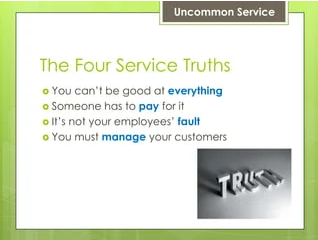 This is the first step in getting accountability right. In encapsulates truth #3 from Frances Frei and Anne Morriss’ Uncommon Service: How to Win by Putting Customers at the Core of Your Business, “It’s not your employees’ fault.”
This is the first step in getting accountability right. In encapsulates truth #3 from Frances Frei and Anne Morriss’ Uncommon Service: How to Win by Putting Customers at the Core of Your Business, “It’s not your employees’ fault.”
Leadership fails to understand behavior is the issue with poor performance, even if they are aware they are stymied without any solution to improve it.
To change your business culture, behavior is what needs to change. Uncommon Service provides three questions to empower organizations to change.
The questions that matter are:
- What’s the problematic behavior?
- What are the shared basic assumptions driving that behavior?
- What can we do to change those assumptions?
Frei and Morris believe wrestling with these questions is empowering. Most people feel their organizational culture is something they must endure, it’s not within their power to change.
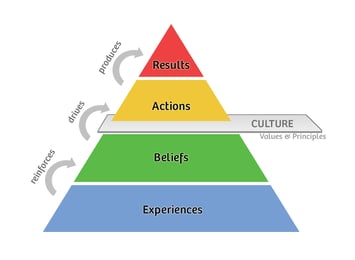 For a better understanding of how to change beliefs and behaviors I recommend Propeller: Accelerating Change by Getting Accountability Right by Tanner Corbridge, Jared Jones, Craig Hickman, and Tom Smith.
For a better understanding of how to change beliefs and behaviors I recommend Propeller: Accelerating Change by Getting Accountability Right by Tanner Corbridge, Jared Jones, Craig Hickman, and Tom Smith.
Accountability - Avoid the Action Trap. Experiences & Beliefs Drive Actions & Results shares how most managers' attempts to achieve change, focus on the top of the Results Pyramid: Actions and Results.
Either you will manage your culture, or it will manage you.
Experience drives beliefs. Propeller provides several examples.
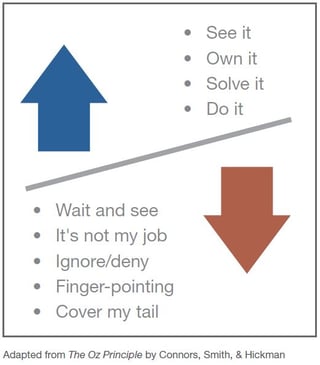 A hospital wanted to improve its customer satisfaction scores. Government reimbursements depend on these scores. A consulting team interviewed the hospital’s front-line employees to discover the current narrative. The shared and believed story in the culture was “We don’t have enough headcount to get the job done for our patients.” People chalked up the problem to understaffing. “You can’t get a hundred gallons of milk out of one cow,” one head nurse offered.
A hospital wanted to improve its customer satisfaction scores. Government reimbursements depend on these scores. A consulting team interviewed the hospital’s front-line employees to discover the current narrative. The shared and believed story in the culture was “We don’t have enough headcount to get the job done for our patients.” People chalked up the problem to understaffing. “You can’t get a hundred gallons of milk out of one cow,” one head nurse offered.
This staffing explanation bewildered leadership. “No way,” said the CEO. “Our staffing levels are higher than industry norms. And this hospital’s nurse-to-patient ratios are third highest in the state.”
This was the paradox. “Your numbers prove that understaffing does not explain the slow progress, but your people still believe it does because that excuse has been fully woven into your organization’s culture and narrative.”
The narrative was so deeply entrenched one nurse told the consulting team understaffing was a big problem because “That’s what everyone always says when someone asks about our Patient Satisfaction Scores.”
It’s the familiar refrain of “It’s the way we do things around here.”
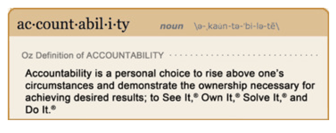 The executive team desperately wanted to create a Culture of Accountability. They weren’t going to make it happen unless they dealt with the organizational narrative that sustained the belief that you could chalk up every problem to understaffing.
The executive team desperately wanted to create a Culture of Accountability. They weren’t going to make it happen unless they dealt with the organizational narrative that sustained the belief that you could chalk up every problem to understaffing.
People would not move Above the Line until they abandoned their Below the Line narrative and the beliefs that went along with it.
Want to change the culture? Change the narrative.
Belief bias always creates narratives in organizations. Belief bias often looks daunting, almost insurmountable. You can overcome belief bias, but it takes deliberate and focused effort through an effective proven process.
Every organization has its narratives. These stories explain “the way we do things around here” or why problems happen. Leaders need to discover and understand those narratives before they attempt to make any meaningful, lasting changes in their organizational culture.
Here’s how to Rewrite Your Organizational Narrative
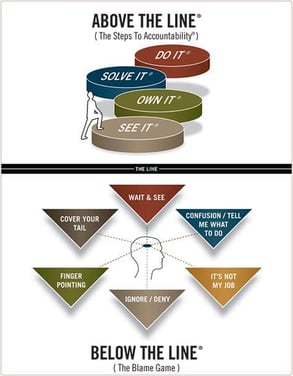 Step 1: Identify the Narrative Propeller: Accelerating Change by Getting Accountability Right recommends detecting the existing narrative in three ways: listen, listen, and listen. Set aside your own assumptions, put on your humble earphones, and ask people to tell you the stories that support their cultural beliefs. Don’t argue, judge, or express shock and bewilderment. It may require several conversations before people feel comfortable telling you the unvarnished truth. Your patience will be rewarded with a deeper understanding of what your people believe and why they believe it. Here’s an example of a good response, “Thank you for your honesty about the Patient Satisfaction Scores. I needed to hear that.”
Step 1: Identify the Narrative Propeller: Accelerating Change by Getting Accountability Right recommends detecting the existing narrative in three ways: listen, listen, and listen. Set aside your own assumptions, put on your humble earphones, and ask people to tell you the stories that support their cultural beliefs. Don’t argue, judge, or express shock and bewilderment. It may require several conversations before people feel comfortable telling you the unvarnished truth. Your patience will be rewarded with a deeper understanding of what your people believe and why they believe it. Here’s an example of a good response, “Thank you for your honesty about the Patient Satisfaction Scores. I needed to hear that.”
Step 2: Share Your Reaction to the Narrative Once you have learned the narrative, let your people know what you think about it. State your reaction positively, making sure you do not express anger or ridicule even if you think the narrative represents Below the Line thinking. For example, “I understand why you feel that way about Patient Satisfaction Scores. I would probably think that way too if I were in your shoes. But bear with me a minute. Let me share a different perspective.”
Step 3: Create a Compelling Case for the New Narrative You can’t command or force people to change and expect it to result in positive, lasting change. People need the opportunity to choose for themselves whether they will change. You must make a compelling case for change that convinces them that it’s in their best interest and is the best way to get the needed results. Of course, you need to model the change yourself. 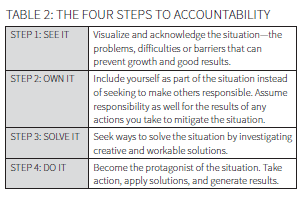 What you’re doing is creating a new, more powerful narrative to replace the old one. For example, “Our survey shows that understaffing does not fully explain our slow progress, but let’s set that aside for the moment. I’d like to tell you about St. Mary’s Hospital in Detroit. It gets better scores than we do with a much lower nurse-to-patient ratio. One of their administrators recently shared with us an amazing story about getting more with less.”
What you’re doing is creating a new, more powerful narrative to replace the old one. For example, “Our survey shows that understaffing does not fully explain our slow progress, but let’s set that aside for the moment. I’d like to tell you about St. Mary’s Hospital in Detroit. It gets better scores than we do with a much lower nurse-to-patient ratio. One of their administrators recently shared with us an amazing story about getting more with less.”
Step 4: Invite Your People to Help Define the New Narrative Rather than impose a new narrative on the organization, encourage your people to tell you the beliefs that should help shape a new narrative. Most of us like to tell and listen to good stories. For example, “You can see why I love that story about St. Mary’s. I wonder if you’ve seen anything like that happen here in the past two years. We’re looking for examples that illustrate this new way of working.”
When you hear a good story that supports the change initiative, repeat it frequently and ask your people to retell it until it becomes part of the new narrative. It will likely take many stories and many weeks or months, but a new narrative will emerge, and that new narrative will do more to promote a desired culture change than all the memos and mandates in the world.
Experiences Change Beliefs.
 Belief Bias, as well as the Organizational Narrative, Need to Be Known and Managed.
Belief Bias, as well as the Organizational Narrative, Need to Be Known and Managed.
In Propeller: Accelerating Change by Getting Accountability Right clarity begins with defining above-the-line and below-the-line behavior. One is proactive, the other reactive.
When you’re serious about changing your company’s culture, the first place to start is with yourself. It begins with taking personal responsibility for making things happen.
To create an environment where everyone is inspired to give their best, contact Positioning Systems to schedule a free exploratory meeting.
Turn your team into a growth organization.
Growth demands Strategic Discipline.
 How many of you wish your employees would just act like owners? Next blog we explore The Great Game of Business and Jack Stack’s answer to how to get your team to act like owners.
How many of you wish your employees would just act like owners? Next blog we explore The Great Game of Business and Jack Stack’s answer to how to get your team to act like owners.
Building an enduring great organization requires disciplined people, disciplined thought, disciplined action, superior results, producing a distinctive impact on the world.
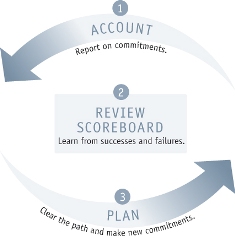 Discipline sustains momentum, over a long period of time, laying the foundations for lasting endurance.
Discipline sustains momentum, over a long period of time, laying the foundations for lasting endurance.
A winning habit starts with 3 Strategic Disciplines: Priority, Metrics, and Meeting Rhythms. Forecasting, accountability, individual, and team performance improve dramatically.
Meeting Rhythms achieve a disciplined focus on performance metrics to drive growth.
Let Positioning Systems help your business achieve these outcomes on the Four most Important Decisions your business faces:
|
DECISION |
RESULT/OUTCOME |
|
PEOPLE |
|
|
STRATEGY |
|
|
EXECUTION |
|
|
CASH |
|
Positioning Systems helps mid-sized ($5M - $500M+) businesses Scale-UP. We align your business to focus on Your One Thing! Contact dwick@positioningsystems.com to Scale Up your business! Take our Four Decisions Needs Assessment to discover how your business measures against other Scaled Up companies. We’ll contact you.
NEXT BLOG – Get Your Employees to Think and Act Like Owners.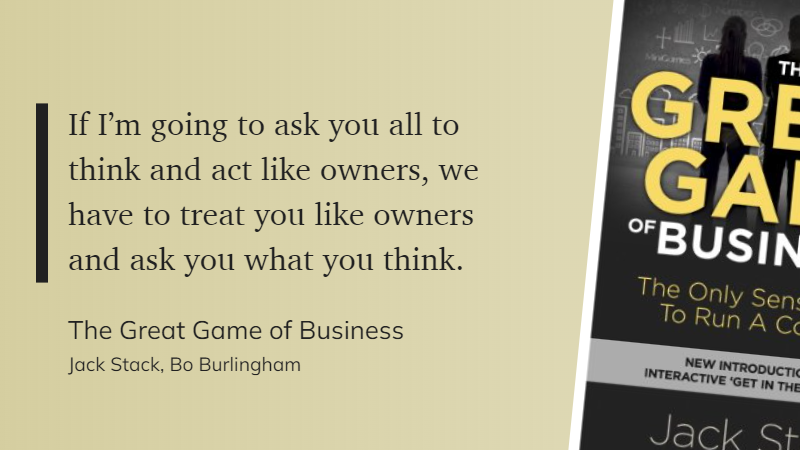






.jpeg?width=150&height=135&name=Hand%20with%20marker%20writing%20the%20question%20Whats%20Next_%20(1).jpeg)

